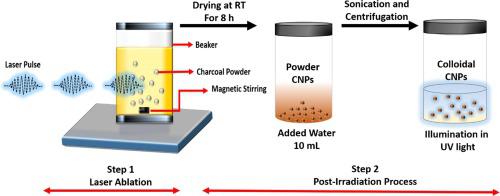Optics & Laser Technology ( IF 4.6 ) Pub Date : 2020-11-12 , DOI: 10.1016/j.optlastec.2020.106717 Gaurav Kumar Yogesh , E.P. Shuaib , A. Kalai Priya , P. Rohini , Sathyan Vivekanand Anandhan , Uma Maheswari Krishnan , V. Kalyanavalli , Shivam Shukla , D. Sastikumar

|
Traditionally, CNPs directly obtained from nanosecond pulsed laser ablation (ns-PLA) in an organic solvent like ethanol, isopropyl alcohol and acetone, possess toxic characteristics with excellent fluorescent properties. However, water-soluble CNPs are found to be non-toxic with weak fluorescent properties. In this study, a post-ablation method was utilized to achieve water-soluble fluorescent CNPs. Initially, the colloidal Eth-CNPs solution was obtained from ns-PLA of charcoal powder in the ethanol, which was subsequently dried at room temperature and then dispersed in water to achieve the final water-soluble CNPs (W-CNPs). The High-resolution Transmission Electron Microscopy (HRTEM) image analysis of W-CNPs shows quasi-spherical size particle distribution with an average particle size found to be around 21 nm. XPS studies of charcoal powder and W-CNPs confirm the creation of fluorescent emissive defects state on the surface of W-CNPs under laser ablation in ethanol. Photoluminescence studies of W-CNPs demonstrated the wavelength-dependent PL emission, with peak PL emission in the blue region of the visible spectrum. In vitro studies indicated the non-toxic nature of the W-CNPs at low and high concentration (1, 5 and 10% v/v) in human cardiomyocytes. Herein, the W-CNPs obtained from post-ns-PLA was found to exhibit both blue and green fluorescence in the cardiomyocytes and hence, it can be exploited as a fluoro probe in bioimaging applications.
中文翻译:

纳秒脉冲激光烧蚀在乙醇中合成水溶性荧光碳纳米颗粒(CNP)
传统上,由纳秒脉冲激光烧蚀(ns-PLA)直接在有机溶剂(如乙醇,异丙醇和丙酮)中获得的CNP具有毒性和荧光特性。然而,发现水溶性CNP是无毒的,具有弱的荧光性质。在这项研究中,后消融方法被用来实现水溶性荧光CNP。最初,从乙醇中木炭粉的ns-PLA获得胶体Eth-CNPs溶液,随后将其在室温下干燥,然后分散在水中以得到最终的水溶性CNP(W-CNPs)。W-CNP的高分辨率透射电子显微镜(HRTEM)图像分析显示了准球形粒径分布,平均粒径约为21 nm。对木炭粉和W-CNPs的XPS研究证实,在乙醇中进行激光烧蚀后,W-CNPs表面产生了荧光发射缺陷状态。W-CNP的光致发光研究表明,波长依赖的PL发射,在可见光谱的蓝色区域具有峰值PL发射。体外研究表明,低浓度和高浓度(1、5%和10%v / v)的W-CNP对人心肌细胞无毒。在此,发现从ns-PLA后获得的W-CNP在心肌细胞中同时显示蓝色和绿色荧光,因此,可以将其用作生物成像应用中的荧光探针。











































 京公网安备 11010802027423号
京公网安备 11010802027423号